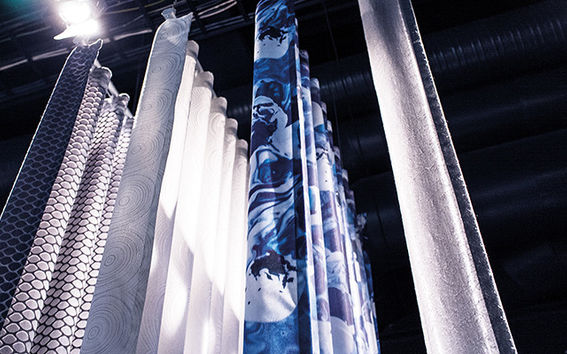Woven Sounds

During internship Haikonen noticed that there was a narrow but open space for visually interesting acoustic curtains in the market. At the present market all acoustic curtains are quite plain and simple. The work is done in collaboration with an Italian weaving mill Lodetex where Haikonen also did an internship during spring and summer 2015. Lodetex has the equipment and the knowledge to produce patterned jacquards and digital prints, so Haikonen wanted to focus on that.
Why acoustic curtains are used then? Lightweight acoustic curtains cannot be compared with heavy acoustic panels, since their absorption abilities are different, but acoustic curtains are effective in spaces where mid to high frequencies are to be toned down, such as open offices. There are many advantages for using acoustic curtains: for example their easy application and maintenance, relatively low costs, and adjustable nature. Acoustic curtains can easily replace regular curtains in interiors without adding any extra elements, and by chancing the draping of curtains or the placement it is easy to adjust the acoustics of the interior. “One does not have to be an acoustic expert in order to improve the living room acoustics by using acoustic curtains”.
Haikonen´s research is a practice-based study where the design process is equally important outcome as the final products. In the theoretical part of the thesis Haikonen studied the behaviour of sound and room acoustics with the focus on sound absorption of porous materials. Porous materials are able to absorb excessive sound, so that the echo effect and the volume of sound within indoors decreases, and the sound environment becomes more pleasant. Sound absorptive materials are tested and given an alpha value which indicates how much sound materials are able to absorb within different frequency ranges.
The design process of woven acoustic fabrics aims for creating a balanced fabric cover. The surface of the fabric should be dense enough for the sound wave to absorb, but not too dense, otherwise the sound wave just reflects from the surface. Another goal is to create as much absorbing surface to the fabric as possible. ”It is not just about the volume of the draped curtains but also the three-dimensional microstructural surface area of the fabric as well” says Haikonen. There are several factors that affect the fabric cover and the surface area: fabric’s internal factors such as density, woven structures, thickness, and layering, and also external factors as the amount of draping, the airspace behind the curtain, and how the curtains are placed within the room.
The actual development work of acoustic curtain fabrics included phases of prototyping and testing the prototypes, analysing the test results and developing the prototypes further. “In addition to testing the absorption abilities of the prototypes in a certified laboratory in Germany, I also created my own home testing for quick tests of the prototype fabrics. The analysis of the test results showed the importance of the fabric cover and the high surface area, but it also revealed that different finishing techniques affect to sound absorption performance”, says Haikonen.
The development work includes around 50 woven jacquard prototype fabrics with various structural and material combinations, and also some digital print designs. In addition to the functional design work based on sound absorption, the visual designs were also created with sound as a sketching tool and inspiration. Haikonen used for example digital audiovisual programming, where wave drawings and colour gradients were rendered based on the played sounds. She also used sound for vibrating materials, such as water, for creating patterns. The fabrics do not only take in excessive sound, but they also include visual sound stories, for example a moment on a lake where loons are calling each other. ”I wanted to use sound as the whole concept of the work, not only for the technical part, but for the visuals as well.” Haikonen’s new collection has raised a great interest in acoustic curtain market.
MA Thesis in Department of Design,
Petra Haikonen: Woven Sounds / Design Exploration and Experimentation of Acoustic Curtain Fabrics
- Published:
- Updated:
Read more news

Aalto ARTS alum Vidha Samya’s artwork featured at the Venice Biennale 2024
The Pavilion of Finland presents ‘The pleasures we choose’ at the 60th International Art Exhibition – La Biennale di Venezia until 24 November 2024.
IoT Forge donates EUR 1 million to the School of Engineering
The donation will be used for research and education on the Industrial Internet and digital twins.
Join us for the first Aalto Open Science Award Ceremony
All Aaltonians are welcome – no registration required!